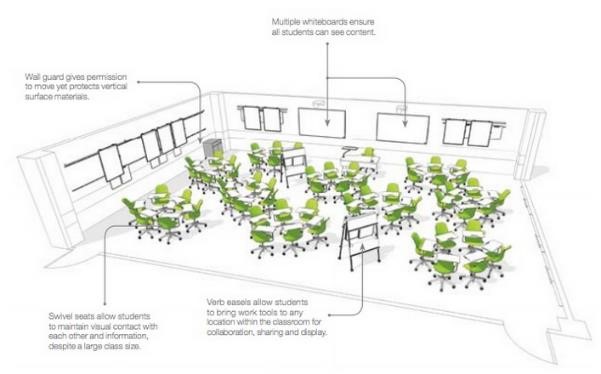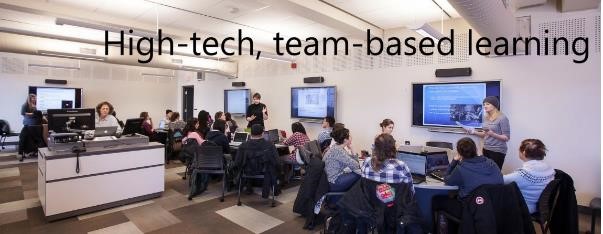Lesson 2 - Online Learning and Teaching Methods
6. The Future of the Campus
6.3. The Impact of Online Learning on the Campus Experience
This question becomes particularly important when we examine how an increased move to blended or hybrid learning is going to impact on learning spaces. In some ways, this may turn out to be a ticking time bomb for schools, colleges and universities.
Rethinking the Design of Classrooms
As we move from lectures to more interactive learning, we will need to think about the spaces in which learning will take place, and how pedagogy, online learning and the design of learning spaces influence one another. To make it worthwhile for students to come to campus when they can do an increasing amount of their study online, on-campus activities must be meaningful. If for instance, we want students to come to campus for interpersonal communication and intense group work, will there be sufficiently flexible and well-equipped spaces for students to do this, remembering that they will want to combine their online work with their classroom activities?
In essence, new technology, hybrid learning and the desire to engage students and to develop the knowledge and skills needed in a digital age are leading some teachers and architects to rethink the classroom and the way it is used.

Steelcase, a leading American manufacturer of office and educational furniture, is not only conducting impressive research into learning environments, but is way ahead of many of our post-secondary institutions in thinking through the implications of online learning for classroom design. Their educational research website, and two of their reports: Active Learning Spaces and Rethinking Space: Sparking Creativity are documents that all post-secondary institutions and even k-12 planners should be looking at.
In Active Learning Spaces, Steelcase reports:
Formal learning spaces have remained the same for centuries: a rectangular box filled with rows of desks facing the instructor and writing board….As a result, today’s students and teachers suffer because these outmoded spaces inadequately support the integration of the three key elements of a successful learning environment: pedagogy, technology, and space.
Change begins with pedagogy. Teachers and teaching methods are diverse and evolving. From one class to the next, sometimes during the same class period, classrooms need change. Thus, they should fluidly adapt to different teaching and learning preferences. Instructors should be supported to develop new teaching strategies that support these new needs.
Technology needs careful integration. Students today are digital natives, comfortable using technology to display, share, and present information. Vertical surfaces to display content, multiple projection surfaces, and whiteboards in various configurations are all important classroom considerations.
Space impacts learning. More than three-quarters of classes include class discussions and nearly 60 percent of all classes include small group learning, and those percentages are continuing to grow. Interactive pedagogies require learning spaces where everyone can see the content and can see and interact with others. Every seat can and should be the best seat in the room. As more schools adopt constructivist pedagogies, the “sage on the stage” is giving way to the “guide on the side.” These spaces need to support the pedagogies and technology in the room to allow instructors who move among teams to provide real-time feedback, assessment, direction and support students in peer-to-peer learning. Pedagogy, technology and space, when carefully considered and integrated, define the new active learning ecosystem.
In Rethinking Space: Sparking Creativity, Andrew Kim, Steelcase Education Researcher, states:
Creative work is most effective in learning spaces that support team work flow and sharing of information.

The design of classroom spaces now needs to take into account that students are doing an increasing amount of their work online (and often outside the classroom). The classroom must support opportunities for accessing, working on, sharing, and demonstrating knowledge gained both within and outside the classroom. Thus if the classroom is organized into ‘clusters’ of furniture and equipment to support small group work, these clusters will also require power so students can plug in their devices, wireless Internet access, and the ability to transmit work to shared screens around the room (in other words, a class Intranet). Students also need quiet places or breakout spaces where they can work individually as well as in groups. When faculty are presented with such use of space, they naturally adopt more active learning approaches.
The Impact of Flipped Classrooms and Hybrid Learning on Classroom Design
These classroom designs assume that students are learning in relatively small classes. However, we are also seeing the redesign of large lecture classes using hybrid designs such as flipped classrooms. Indeed Mark Valenti (2013) of the Sextant Group (an audio-visual company) is reported as saying: ‘We’re basically seeing the beginning of the end of the lecture hall.’
Nevertheless, given the current financial context, we should not assume that the classroom time for these redesigned large lecture classes will be spent in small groups in individual classrooms (there are probably not enough small classrooms to accommodate these classes which often have over a thousand students). Larger spaces that can be organized into smaller working groups, then easily reconvened into a large, single group, will be needed. What the space for these large classes certainly should not be is the raked rows of benches which now are now the norm in most large lecture theatres.
Steelcase is also doing research on appropriate spaces for faculty. For instance, if a university or department is planning a learning commons or common area for students, why not locate faculty offices in the same general area instead of in a separate building? Indeed, a case could be made for integrating faculty office space with more open teaching areas.
The Impact on Capital Building Plans
It is obvious why a company such as Steelcase is interested in these developments. There is a tremendous commercial opportunity for selling new and better forms of classroom furniture that meets these needs. However, that is the problem. Universities, colleges and especially schools simply do not have the money to move quickly towards new classroom designs, and even if they did, they should do some careful thinking first about:
- What kind of campus will be needed over the next 20 years, given the rapid moves to hybrid and online learning?
- How much they need to invest in physical infrastructure when students can do much of their studies online?
Nevertheless, there are several opportunities for at least setting priorities for innovation in classroom design:
- Where new campuses or major buildings are being built or renewed?
- Where large first and second year classes are being redesigned: maybe a prototype classroom design could be tried for one of these large lecture redesigns and tested; if successful the model could be added slowly to other large lecture classes.
- Where a department or program is being redesigned to integrate online learning and classroom teaching in a major way; they would receive priority for funding a new classroom design?
- All major new purchases of classroom furniture to replace old or worn out equipment should first be subject to a review of classroom designs.
The important point here is that investment in new or adapted physical classroom space should be driven by decisions to change pedagogy/teaching methods. This will mean bringing together academics, IT support staff, instructional designers, and staff from facilities, as well as architects and furniture suppliers. Second, as Winston Churchill said: ‘We shape our buildings and afterwards our buildings shape us.’ Providing teachers and instructors with a flexible, well-designed learning environment is likely to encourage major changes in their teaching; stuffing them into rectangular boxes with rows of desks will do the opposite.
Perhaps most important of all, institutions need to start re-examining their future growth plans for buildings on campus. In particular:
- Will we need additional classrooms and additional lecture theatre buildings if students will be spending up to half their time studying online or in flipped classes?
- Do we have enough learning areas where large numbers of students can work in small groups and can then quickly reconvene?
- Do we have the technical facilities that will allow students seamlessly to work and study both face-to-face and online, and to share and capture the work when working physically together on campus?
- Would we be better investing in the re-design of existing space rather than building new learning spaces?
What is clear is that institutions now need to do some hard thinking about online learning, its likely impact on campus teaching, and above all what kind of campus experience we want students to have when they can do much of their studying online. It is this thinking that should shape our investment in buildings, desks, and chairs.